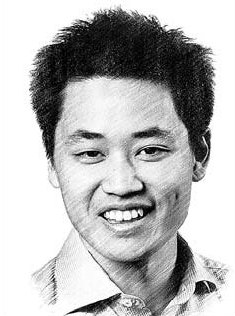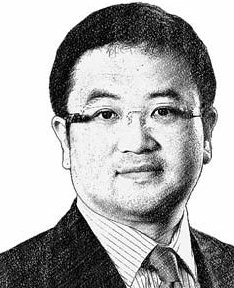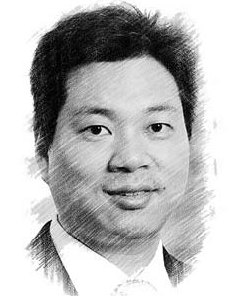|
 |
|
|
Editor's Note: Cautiously optimistic, that can be the description of the economists' general feedback on the latest data about China's economic performance, at least according to the views that China Daily has collected here. Many fears that investors had in earlier weeks are gone, particularly after the industry's stronger growth from June. Apparently, the mini-stimulus program designed by Premier Li Keqiang has been working. For the remainder of the year, the stabilization of the industrial sector may be followed by more investment in fixed assets, such as the much talked-about Central and West China high-speed rail system. And more investment may be followed by more consumer spending. At the same time, the economists' remaining concerns stand out more clearly than ever - about how China will free itself from the entanglement of an opaque financial system, a legacy from the lack of financial and fiscal reform in the previous decade, and the mounting debt that local governments have collected. This is exactly where China's next reform effort will have to focus. |
|
 |
|
|
The most important indicator right now is industrial production. Out of the official monthly data, industrial production is the best gauge of economic activity in China. The rebound in July suggests that the economy was recovering from the financial stress seen in June. As such, our GDP-tracking model indicates that third-quarter growth could rebound to around 7.8 percent to 8.3 percent.
No, the July surge was due to a rebound from a weak June. Data for August and September are likely to be in line with our expectations for mildly below-trend growth. That said, the government's 7.5 percent GDP growth target for this year looks attainable, and the risk of a hard landing as a result of problems in financial markets has receded. The government's "mini-stimulus" program announced in late July - comprising a cut in the small-business tax, a pledge to boost railway construction, and easier financing for exporters - may have a small impact later this year, but the effect was negligible in July, as fixed investment was flat. The best-case scenario seems to be a further flat trend in investment, as continued restrictions on the housing market and bans on erecting new government buildings will cap construction. 
The most important sign of transition will be a clear government commitment to reform. Top officials from Premier Li and President Xi down have signaled a strong preference for reform rather than short-term stimulus to boost growth. But apart from some financial liberalization there has not been anything fundamentally transformational announced so far. Hopefully some meaningful reforms will be announced at a high-level policymaking conference in October, and hopefully there will be a clear commitment toward their implementation.
The government has a clear capacity to boost short-term growth if necessary via fiscal and monetary policy. Longer-term growth is the bigger question. The biggest challenge is aligning the interests of everyone in government toward further reform and market liberalization. There are many problems ahead, such as the aging population and shrinking workforce and the buildup of debt from the 2009-10 stimulus and so on, which will be much easier to deal with if economic growth is faster. Economic reforms kick-started China's economic development, and further reforms will enable it to continue growing and avoid the middle-income trap, which is a situation where economic growth in developing economies stagnates and per capita income stops converging with developed countries. Of course, this is easier said than done, which is why it is the economy's biggest challenge. ----- Alaistair Chan |
|
|
Retail sales is really the only major indicator that's been showing a clear uptrend since March. It has risen consistently on a year-to-date basis, showing that the underlying momentum of the economy is not too weak. This indicator is quite important due to its more stable nature relative to trade. During an economic slowdown, it is easy to get carried away by wildly swinging trade numbers, making it difficult to assess the actual health of the economy.
China is now undergoing a structural reform phase. Given its long-term nature, the concern shouldn't be on the next few months' economic data. The key concern is whether China can get through this transition smoothly. Because we are at the beginning of such transition, hiccups are inevitable, and economic growth is set to slow further from present levels. However, we think a full-year growth rate above 7 percent can be tolerated. 
China is clearly steering away from the old model of excess credit-fueled investment. The leadership is now more reticent about initiating massive, across-the-board economic stimulus programs and is holding back from monetary stimulus despite the economic slowdown. The leadership has also quickly moved ahead with interest rate liberalization, which ultimately helps to rationalize the lending behavior of banks. This is in line with broader efforts to streamline investments in the future. To complement the rationalization of investment behavior, the government is encouraging investments in certain industries, such as environmental management and intra-city transportation. Economic transition is not a simple case of increasing consumption as a share of GDP. From the way reforms are developing, investment will remain a very important pillar of GDP growth. 
The biggest challenge is untangling the complicated webs of wealth management products and off-balance sheet debt. Not long before the listing of China's State-owned banks, the non-performing loan problem was quite serious. Back then, the shadow-banking system was almost non-existent. Right now, it is difficult to comprehend the scale of the problem. It's a dilemma because if the shadow-banking system is allowed to expand uncontrollably, it will be increasingly difficult to track where the money goes. But tough regulation can restrain shadow banking to a degree that further restrains economic growth. -----Chris Leung |
|
|
Taken together, the July activity indicators suggest that the Chinese economy, having encountered some sluggishness during the first half, seems to be stabilizing and showing some decent pickup in activity going into the third quarter. This is most notable in the solid expansion in the July industrial output figure. From the demand side, exports showed some moderate recovery in July, and the steady slowdown in fixed investment growth since early in the year also appears to be stabilizing. Besides, the solid gain in July imports, especially the pickup in commodity imports (including iron ore and copper), also sheds some positive light on domestic demand conditions.
The July data will remove some of the near-term downside risk to growth. But it remains to be seen how sustainable the pickup in July activity will be in the next few months. Regarding our GDP forecast for the second half, we expect the headline year-on-year real GDP growth rate to be 7.4 percent in the third quarter and 7.0 percent in the fourth. Our full-year 2013 GDP growth forecast stands at 7.4 percent with 7.2 percent in 2014. Policy uncertainty has been a major driver of market sentiment and economic activity in China, especially in recent months. In July, the State Council and the Politburo mid-year conferences attempted to restore market confidence via clarifications of economic policies. Premier Li Keqiang reiterated this year's growth target of 7.5 percent and clarified the growth floor at 7 percent. In addition, mini-reform measures were announced to combine the targets of stable growth and economic restructuring. 
The nation's economy is transitioning toward a more consumption-oriented growth model instead of an investment-oriented one. However, in July, retail sales growth was softer than expected, probably reflecting the constraint of slower income growth. Urban household disposable per capita income increased at a modest pace of 6.5 percent in the first half, undershooting real GDP growth. To rebalance the pattern of economic growth, in the short and middle term, the government should solve the main problems, including industrial over-capacity and inefficient investment. Yuan appreciation has also negatively affected exports since the second quarter. We suggest the currency should be allowed some depreciation. Also, policy fine-tuning has started. On the fiscal side, the government is pushing for a compositional shift in fiscal expenditure by cutting administrative public expenditure and increasing spending on social welfare, infrastructure and the service sector. On the monetary side, policymakers are trying to restore the effectiveness of credit policies by cracking down on speculative activity in the financial sector and guiding banks to lend more prudently and effectively. In addition, mini-reform measures have been introduced to support domestic demand, such as investments in railways and infrastructure, expansion of VAT reform in the service sector, a tax waiver for small businesses, simplification of investment approval procedures and support measures for exports. We expect more fine-tuning measures in the coming months. The scale and pace of policy fine-tuning will be important to gauge the growth outlook in the second half, and it will also be indicative of the reform agenda expected to be announced during the third plenary session of the Central Committee later this year. 
The biggest remaining challenge for China's economy may be the systemic risks in the financial industry. In recent years, risks have built up in China's financial sector, amid a boom in non-bank financing. We estimate that total social debt rose to 194 percent of GDP in 2012, compared with 145 percent in 2008. Corporate debt reached 124 percent of GDP in 2012. Major sources of risk come from corporate debt, local government debt and the spillover from shadow banking. The financial outlook in China depends on the pace of economic reform going forward. The dilemma faced by policymakers in China is essentially a trade-off between short-term and long-term financial stability. Active de-leveraging is helpful to contain financial risks in the long term, but overly aggressive de-leveraging could cause a hard landing and trigger an abrupt crisis. But bank insolvency is not an immediate risk, and China should pursue structural reform to avoid a repeat of Japan's experience. It means that the delay in structural reform may delay a financial crisis for an extended period, but this comes at the cost of "zombie banks" and "zombie companies", declines in competitiveness and a continuous slowdown in economic growth. -----Zhu Haibin |
|
|
We have seen some momentum in production in July with factory production output up 9.7 percent from a year earlier. Some think the acceleration will help the country avoid an economic slowdown, but that could be a false dawn. There could be some short-term or temporary upswings with production in the future. However, we are not certain whether a trend of recovery will be firmly built. Most likely we will see the economy stuck in a low-growth path for a period longer than we thought before. 
We haven't seen many signs of a change-of-growth model as of yet. But there are indeed signs of greater policy resolve to change the growth model. One of the signs of change is that the government has been refraining from rolling out an all-out stimulus program and instead has been focusing more on structural adjustments lately. 
The biggest remaining challenge is to strike a balance between growth stability and structural adjustment and between policy continuity and reform. Without such a balance, there is a high risk of the economy slipping into a severe slowdown, either now or in the future. -----Ren Xianfang |
|
|
Of the July data, we saw a surprising upbeat mood in foreign trade growth, which bounced back from the negative growth recorded in the previous month. This reflects an improving external environment amid the better-than-expected recovery of developed economies, which will continue to support the foreign trade growth for China for the rest of the year. Therefore, we are optimistic about economic growth for the first quarter next year.
I don't think such momentum can last long. Investment growth in July was partially down to a lower level last year. Investment in the manufacturing sector is stabilizing and infrastructure and housing projects are picking up. Growth in the coming months depends on whether government-led projects could accelerate and offset the negative effect of a weakening investment in manufacturing. But the basis for such investment is frail. Local government investment is still very much constrained by fund shortage because of the debt audit. This year's investment will mainly focus on projects under construction rather than new ones. 
The performance of traditional sectors remains weak, and the overall economic growth still lacks impetus. Manufacturers were very much forced into technical upgrading. This trend is reflected in exports, where high-end manufacturers are playing an increasingly important role. However, the economic transition is still handicapped by the cyclic swing of the economy. The transition should be implemented during a recovery, but the repeated swings are impairing its effectiveness. 
The biggest challenge is that the current economic downturn is adding more pressure to the employment market. In previous years, unemployment pressure would only happen at one end of the job market. Despite job losses for office workers, people in the service sector are still in demand. But now we are seeing millions of college students struggling to find a job. -----Yang Weixiao |











 I mainly look at fixed-asset investment because it is the main driver of China's growth. Investment growth is flat, even though production has ramped up a lot. Total fixed-asset investment (excluding rural households) increased 20.1 percent year-on-year, according to the National Bureau of Statistics in a statement on Friday. With investment growing at 20 percent, the economy remains quite weak. Fixed-asset investment is a key gauge of government spending on infrastructure. Looking forward, we will not see much upside with investment, given huge overcapacity and over-leveraging, which need to be worked off gradually.
I mainly look at fixed-asset investment because it is the main driver of China's growth. Investment growth is flat, even though production has ramped up a lot. Total fixed-asset investment (excluding rural households) increased 20.1 percent year-on-year, according to the National Bureau of Statistics in a statement on Friday. With investment growing at 20 percent, the economy remains quite weak. Fixed-asset investment is a key gauge of government spending on infrastructure. Looking forward, we will not see much upside with investment, given huge overcapacity and over-leveraging, which need to be worked off gradually.


